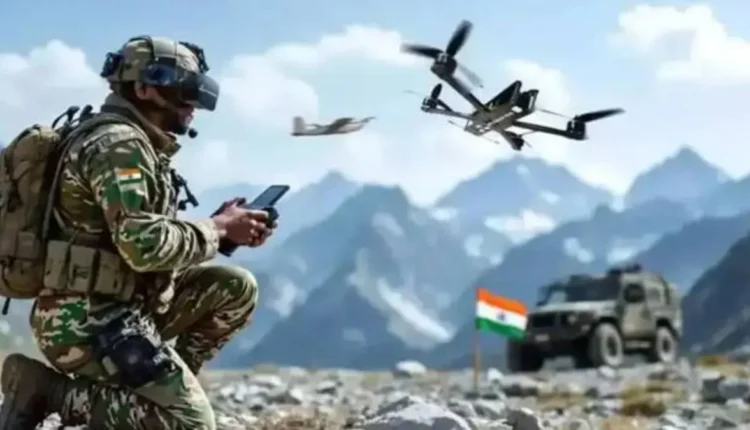In an era where the battlefield is no longer confined to land or sea but has expanded into the unseen dimensions of cyberspace and the air littoral, the Indian Army’s latest initiative — the procurement of the indigenously developed ‘SAKSHAM’ Counter-Unmanned Aerial System (UAS) Grid — represents a decisive step towards redefining national security preparedness. The rise of drones — from surveillance quadcopters to armed autonomous swarms — has transformed warfare across the world. Conflicts in Ukraine, Gaza, Armenia-Azerbaijan, and even along India’s borders have shown how small, inexpensive unmanned aerial vehicles can inflict devastating damage on high-value targets. The threat is no longer theoretical — it is immediate, dynamic, and ever-evolving.
Against this backdrop, SAKSHAM stands as India’s technological answer — a smart, indigenous, and integrated grid system designed to detect, track, identify, and neutralise hostile drones in real time. Genesis: Lessons from the Modern Battlefield The idea for SAKSHAM took shape in the aftermath of Operation Sindoor, when Indian forces encountered unprecedented levels of hostile drone activity. These incursions exposed a critical gap — while ground defences were strong, the “air littoral,” or the low-altitude airspace up to 3,000 metres above the ground, remained a vulnerable and contested zone.
In response, the Army expanded its traditional concept of the Tactical Battle Area (TBA) into a more comprehensive Tactical Battlefield Space (TBS) — a domain that includes both the surface and the air littoral. This doctrinal shift reflects the Army’s understanding that future wars will be multi-domain, fought simultaneously on land, in the air, and through data networks. The challenge is clear: to dominate not just the ground but the invisible sky immediately above it — a zone increasingly filled with drones capable of surveillance, jamming, and kinetic strikes. Inside SAKSHAM: An Intelligent Counter-UAS Network Developed jointly by the Indian Army and Bharat Electronics Limited (BEL), Ghaziabad, SAKSHAM — short for Situational Awareness for Kinetic Soft and Hard Kill Assets Management — is not merely a weapon system. It is an AI-enabled command and control ecosystem, integrating sensors, radars, jammers, and weapon systems into a single, cohesive network. Operating over the secure Army Data Network (ADN), SAKSHAM delivers a unified, real-time picture of all unmanned aerial activity across the Tactical Battlefield Space. The system integrates both friendly and hostile UAS data on a GIS-based digital map, giving commanders unprecedented situational awareness and enabling faster, data-driven decision-making. Among its major functions:
- Generation of a Recognised UAS Picture (RUASP) across the battlefield, updated in real time.
- Integration of soft-kill (jamming, spoofing) and hard-kill (kinetic interception, directed energy) systems for a synchronised defensive response.
- AI-powered threat classification for predictive assessment and prioritised engagement.
- Interoperability with existing airspace management systems and the Akasheer platform, which maps all aerial users — friendly, neutral, or hostile — in the combat zone.
What makes SAKSHAM truly cutting-edge is its modular and scalable architecture. The system can evolve with time — incorporating future sensors, weapons, and AI tools — ensuring long-term adaptability to new forms of aerial warfare. The indigenous nature of the SAKSHAM system stands as a powerful testament to India’s growing self-reliance in defence technology. Under the government’s ‘Atmanirbhar Bharat’ and ‘Make in India’ initiatives, the project exemplifies how advanced defence capability can be developed domestically — reducing dependence on foreign technology while ensuring national security autonomy. The system’s development aligns with the Indian Army’s Decade of Transformation (2023–2032) — a period focused on digitisation, modernisation, and integration of emerging technologies such as AI, robotics, and electronic warfare. Approved under the Fast Track Procurement (FTP) route, the Army aims for field induction of SAKSHAM within a year, marking one of the fastest deployments of an indigenous defence innovation. Strategic and Tactical Significance Once fully operational, SAKSHAM will form the backbone of India’s Counter-UAS Grid — a shield that protects forward bases, logistics hubs, and operational commands from aerial incursions. For field commanders, it means real-time visibility and control over a previously uncertain domain. In practical terms, SAKSHAM’s deployment will:
- Deter hostile reconnaissance attempts along borders and Line of Control (LoC) sectors.
- Neutralise weaponised drones before they can target troops or installations.
- Secure logistics routes and civilian areas in sensitive zones.
- Ensure coordinated airspace management, allowing friendly drones and helicopters to operate safely.
The implications are profound. India’s move to integrate its land-based formations with an airspace control grid reflects a deep understanding of how future wars will be fought — where information, automation, and rapid reaction will determine victory more than brute force. The evolution from the Tactical Battle Area to the Tactical Battlefield Space underscores a larger truth — the nature of warfare itself is transforming. Drones and UAS platforms have democratised airpower, allowing even non-state actors to wield aerial threat capabilities once limited to nation-states. By pre-empting this shift and creating an integrated system like SAKSHAM, the Indian Army is ensuring that it remains not just reactive, but proactively dominant in the fifth domain of warfare — the low-altitude aerial space. As the system undergoes field testing and phased induction, its real measure of success will lie in how seamlessly it integrates with the Army’s existing command infrastructure and how effectively it performs under operational stress. But what is already evident is the strategic foresight behind it — a recognition that national defence in the 21st century requires not just strength, but intelligence. With SAKSHAM, India takes a significant stride towards a digitally enabled, AI-supported, and fully indigenous defence ecosystem, ensuring that every inch of the sky above our soldiers — up to 10,000 feet — remains under watchful control. In the words of a senior Army official, “The battlefield of tomorrow is already here — invisible, fast, and intelligent. With SAKSHAM, we are making sure it is also secure.”


Comments are closed.